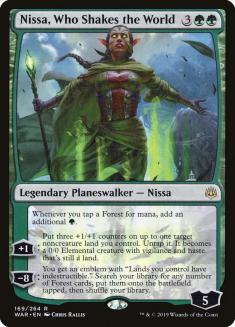It’s Growth Spiral’s world and we’re just living in it.
After earlier bans of Veil of Summer; Oko, Thief of Crowns; and Once Upon a Time, it seems that Simic is still by far the best place to be if you want to win in Ikoria Standard. Oh, we dabbled with our Yorion Jeskai Lukka decks for a while due to the absurdity of Fires of Invention, the companion mechanic, and Agent of Treachery, but thanks to more rebalancing, we swung back to Temur Reclamation, Bant Control, and Sultai Control at the top of the power curve in this format.
Funny how the search for a balanced format through heavy-handed printing of power cards, followed by equally heavy-handed banning to try to undo some of the most egregious offenders, ends up with unsatisfying results.
It’s as if, rather than a metagame resembling an advanced form of rock-paper-scissors, we have something more like a food chain. When one apex predator is removed from the ecosystem, the next one in line rises to the top. This is what the FIRE philosophy has wrought.
Now, a monotonous format is still no reason not to congratulate the top finishers, and in both Players Tour Online 1 and 2, there were a number of big names in the elimination rounds. Elias Watsfeldt, World Championship competitor and Draft Master from a couple of years ago, proved his chops in Constructed by dusting off a big win with the deck that’s sure to be everyone’s jumping-off point until Core Set 2021 is released.
Creatures (3)
Lands (28)
Spells (29)

Yes, we’re back on four maindeck Aether Gust since everyone and their brother is playing with green cards in this format. Even the non-Simic decks, Jund Sacrifice and Mono-Red Aggro, both get tagged by Aether Gust, so at this point it would be a huge disadvantage not to play it in your starting 60.
Oh, and Mystical Dispute, which isn’t quite as all-in as Aether Gust, is another maindeck staple here. Again, most opposing decks will be blue. Not all of them, but most of them. And against Jund Sacrifice, Mystical Dispute as a three-mana Mana Leak isn’t so awful because there are a decent number of expensive spells to tag in the mid-game anyway, like Bolas’s Citadel and Korvold, Fae-Cursed King. But yes, a format where the winning deck plays both Aether Gust and Mystical Dispute maindeck is certainly not a terribly diverse or healthy one.
Now, Temur Reclamation should, in theory, do it all. It uses an incredible enchantment to gain a massive mana advantage. It ramps to an unbeatable end-game with Expansion // Explosion acting as the Gen Z version of Millennials’ Sphinx’s Revelation. It can spit out a giant flying Shark token at instant speed with Shark Typhoon, or just drop one on the battlefield and start making a Shark army. Oh, and it plays the clearly busted Uro, Titan of Nature’s Wrath. Remember, this is all after Oko and Once Upon a Time were banned for making green decks too powerful.
Regardless, it would be foolish to forget about the other busted green mana-doubling engine in Standard, the one that has been on many folks’ radar as a potential ban candidate when green-based ramp decks got too strong over the years.
I’m talking, of course, about Nissa, Who Shakes the World. Nissa is an even more powerful mana engine than Wilderness Reclamation in a lot of contexts. She makes creatures, she doubles mana from Forests immediately (not waiting until the end step), and she can untap a land right away for more mana or a vigilant attacker. The only spots where Nissa is worse than Wilderness Reclamation are when you have multiples of Reclamation and just get to go bananas with triple or quadruple mana for your endgame spells, or else when you play a lot of non-Forest lands. But Nissa is so strong that she anchors a second incredible Simic-based deck, one that looks about as greedy as possible.
Creatures (7)
Planeswalkers (9)
Lands (23)
Spells (21)

Why play Wilderness Reclamation and Expansion // Explosion when you can go with the old reliable, Nissa, Who Shakes the World and Hydroid Krasis? These stalwart cards are still making big moves as an alternative package for generating and leveraging boatloads of mana. And with Teferi, Time Raveler as the big reason to play white, the whole deck looks like a value-hunter’s dream. Teferi essentially shuts down opposing Wilderness Reclamations and makes enemy countermagic look silly. Elspeth Conquers Death also munches on opposing Reclamations and hard-cast Shark Typhoons, doesn’t get hit by Aether Gust or Mystical Dispute, and brings back your Nissas or Teferis that the opponent was able to deal with. I’m a big fan of Bant Control, as so many of their cards are just slam dunks against so many of the best cards in Temur Reclamation.
If I were playing a tournament tomorrow, I would take a hard look at Bant Control as a “paper” to fight Temur Reclamation’s “rock.” It’s not perfect, but it is a deck that isn’t the consensus best deck (so there’s less targeted hate towards it) and it plays a lot of powerful, snowball-y cards. The biggest weakness of the deck is Shark Typhoon, which can slip through a giant Shark token despite a Teferi on the battlefield, and there aren’t a ton of cards in Bant Control to beat that.
The answer, of course, is more Brazen Borrowers, which Louis put in his sideboard and which you can put in your maindeck without sacrificing much at all. The card is versatile enough to be cast basically whenever.
Then, of course, we look at Players Tour Online 2, the time zone twin of Players Tour Online 1. Another solid lineup in the elimination rounds of this event featured one major exception to the Simic world of the first online Top 8, with Eduardo Sajgalik, Eli Loveman, and Christoffer Larsen all playing Jund or Rakdos Sacrifice decks as holdouts against the group consensus.
Creatures (21)
- 4 Priest of Forgotten Gods
- 4 Mayhem Devil
- 4 Gilded Goose
- 1 Korvold, Fae-Cursed King
- 4 Cauldron Familiar
- 4 Woe Strider
Lands (20)
Spells (19)

Without playing Uro or a mana-doubling cheat code card, Eduardo managed to navigate his way to a stellar finish. What can you say? Sometimes Jund is just the way to go! Now, I can appreciate Eduardo’s decision to put one Jegantha, the Wellspring in his sideboard. When an opponent is playing a deck that makes Bolas’s Citadel into a liability, you can simply remove the powerful enchantment and pick up an eighth card in your opening hand! A giant 5/5 is pretty much a freeroll for the deck, though it must be said that one of Jund Sacrifice’s strengths is never running out of things to do with its mana. Thus, spending a bunch of mana to make a big dorky 5/5 is a little suspicious, but if it’s free, you might as well enjoy your free value!
If everyone has given up on companions now that Wizards of the Coast (WoTC) has neutered their power level with some rules errata, it makes sense to claw back some advantage from the base-Simic decks by running with one of the easier companions to enable.
Chris Larsen just ignored the powerful enchantment completely, going with Jegantha as an always-on companion:
Creatures (23)
- 4 Priest of Forgotten Gods
- 4 Mayhem Devil
- 4 Gilded Goose
- 3 Korvold, Fae-Cursed King
- 4 Cauldron Familiar
- 4 Woe Strider
Lands (21)
Spells (16)

This list is clean and powerful, with a lot to like about its matchup against Temur Reclamation. Claim the Firstborn as an answer to Shark Typhoon (and any Uros that have been cast out of the graveyard) is just peachy, and Cindervines as a hate card out of the sideboard is also excellent. I would have expected to see Wilt somewhere in the list, but Cindervines hits the Temur deck with some nickel-and-dime damage before cheaply getting rid of a Wilderness Reclamation and gaining a full turn’s worth of tempo.
One last deck with Growth Spiral, though, before we go.
Kevin Perez excelled with his Sultai Control deck, leveraging the Nissa-Uro-Growth Spiral trio for mana acceleration and topping off with not only Hydroid Krasis but also Casualties of War. That massive blowout sorcery is worth playing, bearing in mind that it is highly vulnerable to the extremely common Aether Gust, while Mystical Dispute or Negate can also tag it for a huge loss of tempo.
If it resolves, though? Most games end. Curving out a Turn 4 Casualties of War is the closest thing we have to cheating out an early Agent of Treachery now that the latter is banned. Even in the late-game, it’s just a tremendous swing and can quickly take an unfavorable battlefield and flip it in your favor.
While I don’t love playing clunky haymakers into a field of lots of cheap counterspells (especially not without Teferi, Time Raveler to try to blank those counterspells in advance) I have to respect Kevin’s gameplan here. He knew what he wanted to do in this tournament and it worked out quite well for him:
Creatures (8)
Planeswalkers (3)
Lands (28)
Spells (21)

So many Casualties of War. So many Thought Distortions in the sideboard for the switcheroo. You have to love the amount of six-mana sorceries in this deck!
Now, with all these green decks running around winning everywhere, what should we not play?
- Don’t play Mono-Red Aggro. It’s just not doing enough right now.
- Don’t play the gimmicky Flourishing Fox cycling decks. They lost a lot when companions were nerfed.
- Don’t outthink yourself. Play the best decks with the most powerful cards.
And keep that last motto in your mind even after Core Set 2021 is released! Your win rate will thank you.



